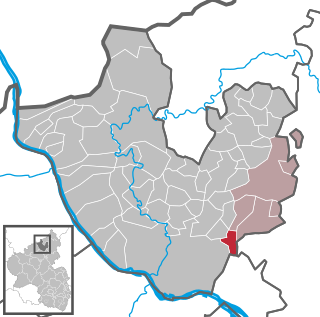Gerlach is a male forename of Germanic origin, variations of which exist in many Germanic and Romance languages. Like many other early Germanic names, it is dithematic, consisting of two meaningful constituents put together. In this case, those constituents are ger and /la:k /. The meaning of the name is thus 'spear thrower'.
It became a surname, and a source from which other surnames have been derived, as well.

The County of Isenburg was a region of Germany located in southern present-day Hesse, located in territories north and south of Frankfurt. The states of Isenburg emerged from the Niederlahngau, which partitioned in 1137 into Isenburg-Isenburg and Isenburg-Limburg-Covern. These countships were partitioned between themselves many times over the next 700 years.
The County of Wied was a territory of the Holy Roman Empire located on the river Wied where it meets the Rhine. Wied emerged as a County earlier than many other German states. From 1243–1462, Wied was united with an Isenburgian County as Isenburg-Wied. Wied was partitioned twice: between itself and Wied-Dierdorf in 1631, and between Wied-Neuwied and Wied-Runkel in 1698. The county was incorporated into the Duchy of Nassau in 1806 and into the Kingdom of Prussia at the Congress of Vienna in 1815. Since 1946, its territory has been part of the German federal state of Rhineland-Palatinate. Via William of Albania, the House of Wied ruled the Principality of Albania in 1914.
Isenburg-Wied was the name of a state of the Holy Roman Empire, based around Neuwied in modern Rhineland-Palatinate, Germany. It was renamed from Isenburg-Braunsberg in 1388, and was superseded by Wied in 1462.
Nieder-Isenburg was a small mediaeval county in northern Rhineland-Palatinate, Germany. It was located to the east of the town of Neuwied, due north of Vallendar.

Isenburg is a municipality in the district of Neuwied, in Rhineland-Palatinate, Germany.

The Prince-Bishopric of Paderborn was an ecclesiastical principality (Hochstift) of the Holy Roman Empire from 1281 to 1802.
Isenburg-Arnfels was the name of a state of the Holy Roman Empire, located in the Bad Hönningen area in modern Rhineland-Palatinate, Germany.
Gerlach II of Isenburg-Arnfels was the Count of Isenburg-Arnfels from 1333 until 1379. After his death, the line of counts of Arnfels was extinct, so the lands were inherited by Isenburg-Wied.
Isenburg-Braunsberg was the name of a state of the Holy Roman Empire, based around the hill Braunsberg. It was created as a partition of Isenburg-Isenburg in 1199 (1210). In 1338 Isenburg-Braunsberg became an Imperial County. It slowly acquired territories of the County of Wied, being renamed to Isenburg-Wied in 1388.
William I of Isenburg-Braunsberg was the Count of Isenburg-Braunsberg from 1327 until 1383. In 1338 William was raised to an Imperial Count.
Gerlach I of Isenburg-Wied was the Count of Isenburg-Wied from 1409 until 1413.
William III of Isenburg-Wied was the Count of Isenburg-Wied from 1413 until 1462.
John II of Isenburg-Wied was the co-Count of Isenburg-Wied from 1415 until 1454.
Henry VIII (1465–1513) was a count of Waldeck and the founder of the older line of Waldeck-Wildungen. He was also temporarily governor of the County of Vianden, a possession of the House of Nassau.
Johanna Sibylla of Hanau-Lichtenberg was the first child of Philipp V, Count of Hanau-Lichtenberg from his first marriage with Countess Ludowika Margaretha of Zweibrücken-Bitsch (1540-1569).

Runkel Castle, a ruined hill castle from the High Middle Ages, is located in the city of Runkel in the Landkreis of Limburg-Weilburg in the state of Hesse.

Arnold II of Isenburg was Archbishop of Trier from 1242 to his death. A long-time member of the cathedral chapter in Trier, he held several provostships before being elected as archbishop, succeeding his uncle Theoderich von Wied. The election was controversial, and king Conrad IV of Germany granted the regalia to Rudolf de Ponte, the opposing candidate, instead. A short military conflict ensued, and the dispute ended after Rudolf's death when Arnold was confirmed as archbishop by Pope Innocent IV and consecrated in 1245.
This page is based on this
Wikipedia article Text is available under the
CC BY-SA 4.0 license; additional terms may apply.
Images, videos and audio are available under their respective licenses.




